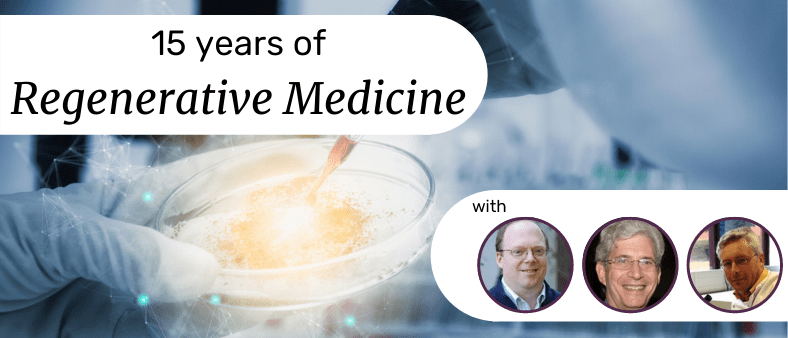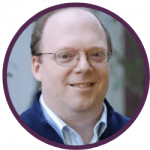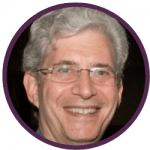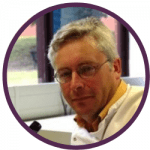Ask the experts: 15 years of Regenerative Medicine, the journal and the field

In this feature, we’ve asked three experts from different areas of regenerative medicine (and members of the Regenerative Medicine editorial board) to discuss the last 15 years of the field and share their predictions for the next 15.
Jump to:
- How did you come to be involved in the journal Regenerative Medicine?
- How has the field of regenerative medicine evolved over the last 15 years?
- What has been the biggest surprise in the field?
- What are your hopes for the next 15 years in the field?
- What are the potential obstacles to this and how might they be overcome?
- How can Regenerative Medicine (and other publications) contribute to the responsible growth of the field?
How did you come to be involved in the journal Regenerative Medicine?
Paul Knoepfler (PK): Over the years as a stem cell researcher I’ve been reading articles in the journal and really valued it as a unique journal in the regenerative medicine field. I also started publishing in the journal and then became an editorial board member..
Bernard Siegel (BS): I became involved in the field as a cancer survivor and patient advocate. Since 2003, I devoted my professional life to accelerating this field. I spoke at many professional and industry events around the world, several chaired by my esteemed colleague, Dr. Chris Mason, Senior Editor of the journal. His writings relating the cell therapies emerging as a 4th pillar of medicine resonated with me and became a framework for my advocacy. My organization was profiled by the journal and I am pleased to be a member of the editorial advisory board.
Glyn Stacey (GS): In my work as the founding director for the UK Stem Cell Bank from 2002-2017, I published regularly on the development of pluripotent stem cells as tools for research and clinical application. I worked closely with a range of academic and commercial groups in the stem cell field and outputs were published in key stem cell biology journals including Regenerative Medicine. These activities led to an invitation to join the Editorial Board for Regenerative Medicine and contributions to RegMedNet.
Jump to
- How did you come to be involved in the journal Regenerative Medicine?
- How has the field of regenerative medicine evolved over the last 15 years?
- What has been the biggest surprise in the field?
- What are your hopes for the next 15 years in the field?
- What are the potential obstacles to this and how might they be overcome?
- How can Regenerative Medicine (and other publications) contribute to the responsible growth of the field?
How has the field of regenerative medicine evolved over the last 15 years?
PK: Focusing first on the positive, I see the field as far more mature now. By that, I mean that we have a much better understanding of not only stem cell biology, but also the challenges faced in getting safe and effective cellular medicine products through the approval process and to patients. We also have far more trials ongoing including some that look very promising.
15 years ago, there may have only been one or two unproven stem cell clinics in the US, but now there are likely around one thousand. This explosion of clinics has harmed the health of scores of patients and muddied the waters. As to the former, there are now concrete data on patients being hurt including via vision loss, infection from contaminated products (at least a dozen patients became septic in just one incident), and other ways. In addition, I see vast economic harm to vulnerable patients and their families. In terms of the muddied waters, it is now much more difficult for patients to be confident in what is a traditional clinical trial versus a strictly for-profit venture by a clinic firm. Sadly, a few universities are also routinely marketing unproven regenerative products.
BS: In 2005, policy and advocacy issues were largely focused on funding and support for embryonic stem cell research. There were societal issues – ethics questions and religious mores to be considered. Somatic cell nuclear transfer (aka nuclear transfer, aka therapeutic cloning) was a red-hot topic and socially conservative lawmakers around were stamp laws criminalizing ethical scientific research. These issues have receded somewhat, as the field has evolved. We now have induced pluripotent stem cell (iPSCs) to deliver pluripotent cells.
GS: Clearly, the discovery of iPSC reprogramming technology by Professor Yamanaka at Kyoto University (Japan) led a revolution in various aspects of research. Many thousands of labs around the world suddenly found themselves in a position to carry out reprogramming and generate stable pluripotent stem cell lines. This drove a rapid development in research experience and technology development in this area, which was significantly accelerated by experience in working with human embryonic stem cells, but would not have been so readily achievable with the then relatively limited access to human embryonic stem cell lines.
Large collections of these iPSC lines are now available through centralized stem cell banks. Quality-controlled stocks of large numbers of cell lines will do much to enhance the reproducibility in pluripotent stem cell-based research. International coordination on hPSCs has also been marked since the mid-2000s with now well-established activities, such as the European Commission-funded hPSCreg hPSC database and the International Stem Cell Initiative, which has published numerous key papers on well-standardized research to enable better understanding of hPSCs.
The International Stem Cell Banking Initiative, started in 2007, has also brought many of the world’s expert hPSC resource centers together to draw consensus on a wide range of banking issues for these challenging cell types. These early initiatives have also supported other international networking activities, such as GAiT. Further significant developments have also emerged such as the NIST genome editing consortium, the Standards Co-ordinating Body and significantly increased interest in standardization within regenerative medicine supported by both established organizations and newer actors.
In more recent years molecular approaches such as combined antibody receptor (CAR) expression on immune cells have emerged and gene editing has diversified and rapidly progressed to the early stages of clinical application. As witnessed with iPSC technology, the broad accessibility to a new and exciting technology, in this case CRISPR/Cas9, has led to a fantastically dynamic science and technology environment in the last 5-10 years. Finally, gene therapy, a technology which emerged in the 1990s, is now beginning to deliver an ever-growing portfolio of medicinal products.
What has been the biggest surprise in the field?
PK: I think iPSC technology took the field by surprise and shook up our assumptions of cell biology and differentiation in a positive way. iPSCs are an exciting technology for many reasons but I also see them as a force to make people think more creatively.
BS: Coming into the field as a lawyer, not a scientist or clinician, I was hoping, and wistfully believed, that stem cells would be in wide use in 15 years. Of course, underestimation of the scientific, regulatory and funding challenges was widespread. My thinking is far more realistic and has evolved way beyond championing a single type of cell or technology. We now have a GIANT convergence of technologies in our discovery toolbox – CRISPR, advances in microscopy, nanotechnology, bioprinting and AI – all in the age of the Internet and instant global communication!
GS: The early and dramatic potential benefits realized from CAR-T immunotherapy has led to very rapid and significant investment in this area which has stimulated interest in new versions of CAR-based treatments, as well as an even broader range of unrelated cell-based therapies. This stimulus has thrown the spotlight on the potential of advanced cell therapies which could drive new discoveries and elevation of roadblocks in the delivery of regenerative medicine.
What are your hopes for the next 15 years in the field?
PK: I hope that we’ll see 5-10 approved regenerative products that truly help patients in some revolutionary ways. We’ve come a long way and the scope of trials out there is impressive. Even if most don’t work out, I think there are going to be some game changers that do.
BS: That the use of cells for effective treatments and cures will be in the doctors’ black bags as tools to alleviate human suffering for everyday and chronic medical conditions, cheap and available for all populations.
GS: I hope that the progress to licensed medicinal products seen for gene therapies will be consolidated for a broader range of applications and that a complementary portfolio of successful targets for long-term effective CAR-T cell therapy, including solid tumors, can be established.
The huge challenges of delivering safe and effective regenerative medicines will hopefully be eased by the development of greater reproducibility and consistency supported by enhanced bioanalytics and automation in regenerative medicine manufacturing.
What are the potential obstacles to this and how might they be overcome?
PK: The unproven clinic industry inserts a lot of chaos into our overall ecosystem. Regulators are already doing a better job of addressing that harmful industry and just need to keep doing more. Technically speaking, cell heterogeneity is always going to be a challenge, but sorting and other technologies like single cell analysis can help. Unfortunately, funding is always a challenge too and an important solution is effective outreach to the public and potential funders.
BS: We underestimate the challenges creating and adopting a new platform of medicine. The science is hard enough. Now we look at cost of goods, reimbursement and regulatory roadblocks. Societal AND established platforms of pharma, biologics and medical devices might be challenged by new inventions and treatments from this emerging field. Certainly funding for basic research and lack of a robust technical workforce to meet cell manufacturing needs have emerged as challenges in our world, a world now facing existential pandemic-related challenges. Public education and ADVOCACY are imperative – without it the field cannot advance.
GS: The desire for highly reproducible and safe products will require a greater understanding of the biology of somatic and stem cell-based approaches and the impact of the in vitro manufacturing environment. This will hopefully stimulate the development and application of a new generation of bioanalytics, including assays of cellular function, which can improve the reproducibility and safety of products and serve the needs of complex and sometimes lengthy manufacturing processes and new automated solutions.
Such developments will also enable stable scale up and consistent disseminated manufacturing, but this will also require the current plethora of enthusiastic standardization initiatives to coordinate effectively and for regulatory authorities to ensure that the regulatory procedures are fit to manage the successful development of new clinical applications and promote internationally harmonized systems.
The cost of goods for complex cell therapeutics remains a significant obstacle to success and a new approach to automation is required that will facilitate scalable and well controlled culture systems combined with enhanced bioanalytics, which will promote our understanding of the impact of new in vitro processing environments and materials.
How can Regenerative Medicine (and other publications) contribute to the responsible growth of the field?
PK: It’s important for journals like Regenerative Medicine to keep up the great work on publishing the latest research and maintain high standards for what they publish. Journals and their editors also encourage responsible publishing and frameworks for the field.
BS: We have a flood of faulty science being reported, without peer-reviewed rigor and with too much hype. Let’s get real – creating scientific revolutions were never easy! Regenerative Medicine is one of the field’s premier publications. Rigorous review, timely publication and collaborations are key.
GS: I believe Regenerative Medicine should continue to communicate emerging issues and development of new important assays for the assessment of regenerative medicine function and safety. In addition, the journal should also communicate key developments in international regulatory processes to inform translational researchers and product developers to facilitate smoother translation of cell therapeutic approaches to clinical application in multiple regulatory jurisdictions.
Jump to:
- How did you come to be involved in the journal Regenerative Medicine?
- How has the field of regenerative medicine evolved over the last 15 years?
- What has been the biggest surprise in the field?
- What are your hopes for the next 15 years in the field?
- What are the potential obstacles to this and how might they be overcome?
- How can Regenerative Medicine (and other publications) contribute to the responsible growth of the field?
Meet the experts
 Paul Knoepfler
Paul Knoepfler
Paul Knoepfler is a Professor at UC Davis School of Medicine (CA, USA) in Cell Biology and Human Anatomy. He’s a stem cell and cancer researcher, but also conducts research and writes about ethics and policy issues. He has run The Niche blog for more than 10 years now and have also written three books.
Bernard Siegel

Bernard Siegel is executive director of the nonprofit Regenerative Medicine Foundation (formerly known as Genetics Policy Institute) (FL, USA) and founder and chair of the World Stem Cell Summit global meeting, an event presented annually since 2005. He serves on numerous boards and committees in our field. Presently and of most topical interest, he co-chairs the advisory board of the Alliance for Cell Therapy NOW (DC, USA), serve on the governing board of Californians for Stem Cell Research, Treatments and Cures (Prop 14) and several National Science Foundation (VA, USA)-related organizations focusing on workforce development for cell and tissue-based products.
 Glyn Stacey
Glyn Stacey
Glyn Stacey is Director for the International Stem Cell Banking Initiative based in the UK and, together with the ISCBI Board and Steering Group, organizes regular international meetings which bring together experts in the field of pluripotent stem cells to discuss best practice in their use for basic research, cell therapy development and other applications. Glyn also holds a position as a President’s International Fellowship Investigator with the Institute of Zoology at the Chinese Academy of Sciences (IOZ-CAS; Beijing, China); in this role, he advises the National Stem Cell Resource Center and the Institute for Stem Cells and Regeneration in their work on development of cell therapies based on pluripotent stem cells. Glyn is also the CEO of the biosciences consultancy SSCBio Ltd (UK), which provides advice and support internationally to a broad range of government institutes and private not-for-profit organizations.
Disclaimer
The opinions expressed in this interview are those of the interviewees and do not necessarily reflect the views of RegMedNet or Future Science Group.